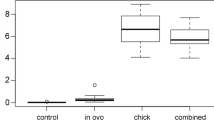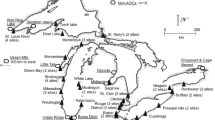Abstract
The reproductive success of wild birds has been affected by exposure to multiple contaminants. Reproduction of captive American kestrels (Falco sparverius) was suppressed when adult birds were exposed to dietary polychlorinated biphenyls (PCBs). In this study, the reproductive effects of in ovo exposure to PCBs is explored, along with determining effects on reproduction in second-generation birds indirectly exposed to PCBs. Reproductive changes in this subsequent generation are examined separately in male and female birds. Captive American kestrels (F. sparverius) were hatched from clutches with eggs containing environmentally relevant levels of total PCBs (34.0 μg/g whole egg WW versus 0 μg/g controls); parent birds had been fed PCB-spiked (Aroclor 1248:1254:1260) food (7 mg/kg BW day−1) for 100 days until their eggs hatched. In 1999, the second-generation PCB birds were paired with unexposed kestrels having reproductive experience. In ovo PCB exposure suppressed egg laying completely in 25% of PCB females and resulted in delays in clutch initiation and smaller clutch sizes for PCB male and female pairs. There was no evidence in this study of in ovo PCB treatment effects on fertility or hatching success. The decline in reproductive success was also reflected in the reduced fledging success and higher incidence of complete brood mortality of PCB nestlings. Differences between in ovo–exposed PCB males and females but not between controls were evident in reproductive success. In ovo PCB exposure appears to have had greater effects on female kestrels until clutch completion, with a greater time lag between pairing and egg laying, reduced numbers of pairs laying eggs, and smaller clutches being laid. In ovo PCB exposure has greater effects later in the breeding season on male kestrels, which had poorer hatching and fledging success relative to the PCB females. Possible behavioral and physiological mechanisms involved in these reproductive changes are discussed.
Similar content being viewed by others
Author information
Authors and Affiliations
Additional information
Received: 25 July 2000/Accepted: 8 December 2000
Rights and permissions
About this article
Cite this article
Fernie, K., Smits, J., Bortolotti, G. et al. In Ovo Exposure to Polychlorinated Biphenyls: Reproductive Effects on Second-Generation American Kestrels. Arch. Environ. Contam. Toxicol. 40, 544–550 (2001). https://doi.org/10.1007/s002440010208
Issue Date:
DOI: https://doi.org/10.1007/s002440010208




